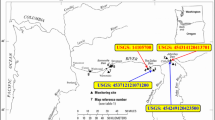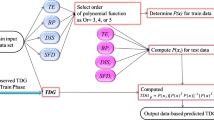Abstract
In the present study, two nonlinear mathematical modeling approaches, namely modified response surface method (MRSM) and multilayer perceptron neural network (MLPNN) were developed and compared for modeling daily dissolved oxygen (DO) concentration. The DO concentration and water quality variables data for several years, available from four stations operated by the United States Geological Survey, were used for developing the two models. The water quality data selected consisted of daily measured river discharge, water pH, specific conductance, water turbidity, and DO. The response surface methodology is modified based on the two steps for calibrating process. In the first regression step, the normalized input data were calibrated based on a linear function and then transferred by an inverse power function. In the second regression step, the input data from first step were used to calibrate a highly nonlinear third-order polynomial function. The accuracy of the proposed nonlinear MRSM is compared with the standard MLPNN using several error statistics such as root-mean-square error, mean absolute error, mean bias error, the coefficient of correlation, the Nash–Sutcliffe efficiency, and the Willmott index of agreement. The results obtained indicate that MRSM model performed best in comparison with the MLPNN for the all four stations.






Similar content being viewed by others
References
Bayram A, Kankal M (2015) Artificial neural network modeling of dissolved oxygen concentration in a turkish watershed. Pol J Environ Stud 24(4):1507–1515
Bayram A et al (2015) Modeling stream dissolved oxygen concentration using teaching-learning based optimization algorithm. Environ Earth Sci 73(10):6565–6576. doi:10.1007/s12665-014-3876-3
Schmid B, Koskiaho J (2006) artificial neural network modeling of dissolved oxygen in a wetland pond: the case of Hovi, Finland. ASCE J Hydrol Eng 11(2):188–192. doi:10.1061/(ASCE)-0699(2006)11:2(188)
Wen X et al (2013) Artificial neural network modeling of dissolved oxygen in the Heihe River, Northwestern China. Environ Monit Assess 185:4361–4371. doi:10.1007/s10661-012-2874-8
Akkoyunlu A et al (2011) Depth-integrated estimation of dissolved oxygen in a lake. ASCE J Environ Eng 137(10):961–967. doi:10.1061/(ASCE)EE.1943-7870.0000376
Heddam S (2016) Simultaneous modelling and forecasting of hourly dissolved oxygen concentration (DO) using radial basis function neural network (RBFNN) based approach: a case study from the Klamath River, Oregon, USA. Model Earth Syst Environ 2:135. doi:10.1007/s40808-016-0197-4
Antanasijević D et al (2013) Modelling of dissolved oxygen content using artificial neural networks: Danube River, North Serbia, case study. Environ Sci Pollut Res 20:9006–9013. doi:10.1007/s11356-013-1876-6
Heddam S (2014) Generalized regression neural network (GRNN) based approach for modelling hourly dissolved oxygen concentration in the upper Klamath River, Oregon, USA. Environ Technol 35(13):1650–1657. doi:10.1080/09593330.2013.878396
Heddam S (2016) New modelling strategy based on radial basis function neural network (RBFNN) for predicting dissolved oxygen concentration using the components of the Gregorian calendar as inputs: case study of Clackamas River, Oregon, USA. Model Earth Syst Environ 2:167. doi:10.1007/s40808-016-0232-5
Ranković V et al (2012) Prediction of dissolved oxygen in reservoirs using adaptive network-based fuzzy inference system. J Hydro Inform 14(1):167–179. doi:10.2166/hydro.2011.084
Heddam S (2014) Modelling hourly dissolved oxygen concentration (DO) using two different adaptive Neurofuzzy inference systems (ANFIS): a comparative study. Environ Monit Assess 186:597–619. doi:10.1007/s10661-013-3402-1
Nemati S et al (2015) Estimation of dissolved oxygen using data-driven techniques in the Tai Po River, Hong Kong. Environ Earth Sci 74:4065–4073. doi:10.1007/s12665-015-4450-3
Kisi O et al (2013) Modeling of dissolved oxygen in river water using artificial intelligence techniques. J Environ Inform 22(2):92–101. doi:10.3808/jei.201300248
Heddam S (2014) Modelling hourly dissolved oxygen concentration (DO) using dynamic evolving neural-fuzzy inference system (DENFIS) based approach: case study of Klamath River at Miller Island Boat Ramp, Oregon, USA. Environ Sci Pollut Res 21:9212–9227. doi:10.1007/s11356-014-2842-7
Olyaie E et al (2016) A comparative analysis among computational intelligence techniques for dissolved oxygen prediction in Delaware River. Geosci Front. doi:10.1016/j.gsf.2016.04.007
Heddam S (2016) Fuzzy neural network (EFuNN) for modelling dissolved oxygen concentration (DO). In: Kahraman C, Sari IU(eds) Intelligence systems in environmental management: theory and applications. Intelligent Systems Reference Library, vol 113. doi:10.1007/978-3-319-42993-9_11
Liu et al (2013) Prediction of dissolved oxygen content in river crab culture based on least squares support vector regression optimized by improved particle swarm optimization. Comput Electron Agric 95:82–91. doi:10.1016/j.compag.2013.03.009
Liu et al (2013) A hybrid approach of support vector regression with genetic algorithm optimization for aquaculture water quality prediction. Math Comput Model 58:458–465. doi:10.1016/j.mcm.2011.11.021
Heddam S (2016) Use of optimally pruned extreme learning machine (OP-ELM) in forecasting dissolved oxygen concentration (DO) Several hours in advance: a case study from the Klamath River, Oregon, USA. Environ Process. doi:10.1007/s40710-016-0172-0
Evrendilek F, Karakaya N (2014) Monitoring diel dissolved oxygen dynamics through integrating wavelet denoising and temporal neural networks. Environ Monit Assess 186:1583–1591. doi:10.1007/s10661-013-3476-9
Evrendilek F, Karakaya N (2014) Regression model-based predictions of diel, diurnal and nocturnal dissolved oxygen dynamics after wavelet denoising of noisy time series. Phys A 404:8–15. doi:10.1016/j.physa.2014.02.062
Evrendilek F, Karakaya N (2015) Spatiotemporal modeling of saturated dissolved oxygen through regressions after wavelet denoising of remotely and proximally sensed data. Earth Sci Inform 8:247–254. doi:10.1007/s12145-014-0148-4
Ravansalar M et al (2016) Prediction of dissolved oxygen in River Calder by noise elimination time series using wavelet transforms. J Exp Theor Artif Intell 28(4):689–706. doi:10.1080/0952813X.2015.1042531
Khani S, Rajaee T (2016) Modelling of dissolved oxygen concentration and its hysteresis behavior in rivers using wavelet transform-based hybrid models. CLEAN—Soil–Air Water. doi:10.1002/clen.201500395
Box GEP, Wilson K B (1951) On the experimental attainment of optimum conditions. J R Stat Soc Ser B 13(1):1–45. www.jstor.org/stable/2983966
Edwards IM, Jutan A (1997) Optimization and control using response surface methods. Comput Chem Eng 21(4):441–453. doi:10.1016/S0098-1354(96)00007-5
Keshtegar B et al (2016) Optimized river stream flow forecasting model utilizing high-order response surface method. Water Resour Manag 30(11):3899–3914. doi:10.1007/s11269-016-1397-4
Gavin HP, Yau SC (2008) High-order limit state functions in the response surface method for structural reliability analysis. Struct Saf 30:162–179. doi:10.1016/j.strusafe.2006.10.003
Jiang SH et al (2014) Capabilities of stochastic response surface method and response surface method in reliability analysis. Struct Eng Mech 49(1):111–128. doi:10.12989/sem.2014.49.1.111
Kaymaz I, McMahon CA (2005) A response surface method based on weighted regression for structural reliability analysis. Probab Eng Mech 20:11–17. doi:10.1016/j.probengmech.2004.05.005
Kang SC et al (2010) An efficient response surface method using moving least squares approximation for structural reliability analysis. Probab Eng Mech 25:365–371. doi:10.1016/j.probengmech.2010.04.002
Xiong F et al (2012) A double weighted stochastic response surface method for reliability analysis. J Mech Sci Technol 26(8):2573–2580. doi:10.1007/s12206-012-0425-4
Li C et al (2002) Optimization of a cultural medium for bacteriocin production by Lactococcus lactis using response surface methodology. J Biotechnol 93(1):27–34. doi:10.1016/S0168-1656(01)00377-7
Ghafari S et al (2009) Application of response surface methodology (RSM) to optimize coagulation–flocculation treatment of leachate using poly-aluminum chloride (PAC) and alum. J Hazard Mater 163(2):650–656. doi:10.1016/j.jhazmat.2008.07.090
Roux WJ et al (1998) Response surface approximations for structural optimization. Int J Numer Meth Eng 42(3):517–534. doi:10.1002/(SICI)1097-0207(19980615)42:3<517:AID-NME370>3.0.CO;2-L
Avalle M et al (2002) Design optimization by response surface methodology: application to crashworthiness design of vehicle structures. Struct Multidiscip Optim 24(4):325–332. doi:10.1007/s00158-002-0243-x
Naceur H et al (2008) Response surface methodology for the rapid design of aluminum sheet metal forming parameters. Mater Des 29(4):781–790. doi:10.1016/j.matdes.2007.01.018
Hykin SS (1999) Neural networks: a comprehensive foundation. Printice-Hall Inc., New Jersey
Wieland R, Mirschel W (2008) Adaptive fuzzy modeling versus artificial neural networks. Environ Model Softw 23:215–224. doi:10.1016/j.envsoft.2007.06.004
Hornik K (1991) Approximation capabilities of multilayer feedforward networks. Neural Netw 4(2):251–257. doi:10.1016/0893-6080(91)90009-T
Hornik K et al (1989) Multilayer feedforward networks are universal approximators. Neural Netw 2:359–366. doi:10.1016/0893-6080(89)90020-8
Keshtegar B et al (2016) A nonlinear mathematical modeling of daily pan evaporation based on conjugate gradient method. Comput Electron Agric 127:120–130. doi:10.1016/j.compag.2016.05.018
Daren Harmel R, Smith PK (2007) Consideration of measurement uncertainty in the evaluation of goodness-of-fit in hydrologic and water quality modeling. J Hydrol 337:326–336. doi:10.1016/j.jhydrol.2007.01.043
Chen WB, Liu WC (2015) Water quality modeling in reservoirs using multivariate linear regression and two neural network models. Adv Artif Neural Syst, Article ID 521721. doi:10.1155/2015/521721
Csábrági A et al (2017) Application of artificial neural networks to the forecasting of dissolved oxygen content in the Hungarian section of the river Danube. Ecol Eng 100:63–72. doi:10.1016/j.ecoleng.2016.12.027
Akaike H (1973) Information theory and an extension of the maximum likelihood principle. In: Petrov BN, Csake F (eds) Second international symposium on information theory. Akademiai Kaido, Budapest, pp 267–281
Akaike H (1974) A new look at the statistical model identification. IEEE Trans Autom Control AC 19:716–723. doi:10.1109/TAC.1974.1100705
Dawson CW et al (2007) HydroTest: a web-based toolbox of evaluation metrics for the standardised assessment of hydrological forecasts. Environ Model Softw 22:1034–1052. doi:10.1016/j.envsoft.2006.06.008
Author information
Authors and Affiliations
Corresponding author
Ethics declarations
Conflict of interest
The authors declare that there are no conflicts of interest regarding this manuscript.
Rights and permissions
About this article
Cite this article
Keshtegar, B., Heddam, S. Modeling daily dissolved oxygen concentration using modified response surface method and artificial neural network: a comparative study. Neural Comput & Applic 30, 2995–3006 (2018). https://doi.org/10.1007/s00521-017-2917-8
Received:
Accepted:
Published:
Issue Date:
DOI: https://doi.org/10.1007/s00521-017-2917-8




